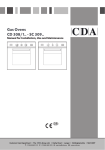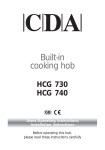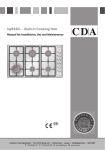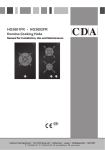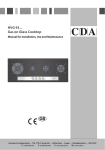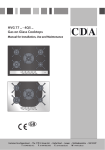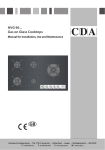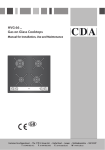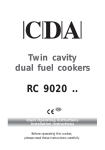Download CDA SC309SS
Transcript
Gas Ovens CD 308/1 SC 309 GB Users Operating Instructions Before operating this oven, please read these instructions carefully Dear Customer Thank you for choosing one of our appliances, carefully designed and built by our specialist staff and thoroughly tested to satisfy your cooking requirements. We suggest that you read this Instruction Booklet so that you will understand fully how to operate your appliance. Please keep the booklet handy. You may wish to refer to it at a later date. CDA The - marking confirms that the appliance conforms to the following EU directives: safety requirements of EEC Directive “Gas” 90/396; safety requirements of EEC Directive “Low voltage” 2006/95/EC; protection requirements of EEC Directive “EMC” 89/336; requirements of EEC Directive 93/68. INSTALLATION The oven must be installed in accordance with the installation instructions contained in this booklet. Connection to the electricity supply must be made by a competent electrician. Warning this appliance must be earthed. BEFORE USE Please ensure that all packing has been removed from the appliance before switching on. 2 Electrical supply to your oven IMPORTANT: Installation must be carried out according to the manufacturer's instructions. Incorrect installation may cause harm and damage to people, animals or property, for which the manufacturer accepts no responsibility. Before carrying out any work on the electrical section of the appliance, it must be disconnected from the mains. Connection to a good earth wiring system is absolutely essential. The manufacturer accepts no responsibility for any inconvenience caused by failure to comply with this rule. DETAILS ✓ Connection to the electric power supply must be carried out by a qualified technician and following the appropriate safety regulations. ✓ Before carrying out the connection to the power supply, the voltage rating of the appliance (stamped on the appliance identification plate) must be checked for correspondence to the available mains supply voltage, and the mains electric wiring should be capable of handling the appliance’s power rating (also indicated on the identification plate). Figure 1 3 amp fuse Green & Yellow Earth Blue Neutral Brown Live 3 ✓ CONNECTION BY A THREE PIN SOCKET (Fig. 1) ➜ The appliance must be connected to a 220-240 volts 50 cycle AC supply by means of a three pin socket, suitably earthed and should be protected by a 3 amp fuse. ➜ If the mains plug is unsuitable for the socket outlet in your home or is removed for any other reason, then the cut off plug should be disposed of safely to prevent the hazard of electric shock. ➜ There is a danger of electric shock if the cut off plug is inserted into any 13 amp socket outlet. ✓ CONNECTION USING FIXED WIRING (Fig. 2) ➜ It is possible to connect the appliance directly to the mains supply by means of a heavy duty switch with 3 mm minimum distance between the contacts. ➜ A double pole switch must be provided no further than 2 metres from the appliance to the electrical supply. All supply current and earth conductors must be able to withstand an ambient temperature of 75°C. ➜ The appliance must be protected by a 3 amp fuse. Figure 2 DOUBLE POLE SWITCHED FUSED SPUR OUTLET FUSE ON 4 GENERAL NOTES ✓ The wires in the mains lead on this appliance are coloured in accordance with the following code: Green and Yellow - Earth Blue – Neutral Brown – Live ✓ As the colours may not correspond with the markings identifying the terminals in your plug or in your spur box, proceed as follows: ➜ The green and yellow wire must be connected to the terminal which is marked with the letter E or with the earth symbol or coloured green and yellow. ➜ The blue wire must be connected to the terminal marked N or coloured black. ➜ The brown wire must be connected to the terminal marked L or coloured red. ✓ The power supply cord must not touch against any hot surfaces and must be placed so that its temperature does not exceed 75°C at any point along its length. ✓ After having installed the appliance, the power switch or power plug must always be in a accessible position. ✓ The appliance must have its own supply; any other appliances installed near it must be supplied separately. ✓ N.B. For connections to the mains power supply, never use adaptors, reductions or multiple power points as these may overheat and catch fire. ✓ In the event that installation should require modifications to the mains supply wiring system or if the power plug is not suitable for the type of power point available, it is recommended that a qualified technician be called to carry out substitution. The technician will also have to verify that the cross-section of the electric cables on the power point match the appliance’s power rating. ✓ If the supply cord is damaged, it must be replaced by a special cord by a qualified electrical technician in order to avoid a hazard. Figure 3 FEEDER SPECIAL CABLE SECTION Type “HO5RR-F” 230 V 230 VAC 50 Hz 3 x 0,75 mm2 ✓ The supply cable must be replaced with a cable of the same type. ✓ The electrical cable must be connected to the terminal board following the diagrams of Fig. 3. 5 PE L1 N(L2) Gas supply requirements IMPORTANT NOTE This appliance is supplied for use on NATURAL GAS or LPG (check the gas regulation label attached on the appliance). 4Appliances supplied for use on NATURAL GAS: they are adjusted for this gas only and cannot be used on any other gas (LPG) without modification. The appliances are manufactured for conversion to LPG. 4Appliances supplied for use on LPG: they are adjusted for this gas only and cannot be used on any other gas (NATURAL GAS) without modification. The appliances are manufactured for conversion to NATURAL GAS. If the NATURAL GAS/LPG conversion kit is not supplied with the appliance this kit can be purchased by contacting the After-Sales Service. INSTALLATION & SERVICE REGULATIONS (UNITED KINGDOM) It is a legal requirement that all gas appliances are Installed & Serviced by a competent person in accordance with the current editions of the following Standards & Regulations or those regulations appropriate to the geographical region in which they are to be installed: = Gas Safety (Installation & Use) Regulations = Building Regulations = British Standards = Regulations for Electrical Installation Installation and service of any gas product must be made by a suitably qualified person competent on the type of product being installed or serviced and holding a valid certificate of competence for the work being carried out. Currently the proof of competence is the Accredited Certification Scheme (ACS) or S/NVQ that has been aligned to the ACS. It is also a requirement that all businesses or self employed installers are members of a class of person approved by the Health and Safety Executive. Currently the only body with such approval is CORGI. Failure to install the appliance correctly could invalidate any manufacturers warranty and lead to prosecution under the above quoted regulation. GAS CONNECTION The installation of the gas appliance to Natural Gas or LP Gas must be carried out by a C.O.R.G.I. registered installer. Installers shall take due account of the provisions of the relevant British Standards Code of Practice, the Gas Safety Regulations and the Building Standards (Scotland)(Consolidation) Regulations issued by the Scottish Development Department. INSTALLATION TO NATURAL GAS Installation to Natural Gas must conform to the Code of Practice, etc. The supply pressure for Natural Gas is 20 mbar. The installation must conform to the relevant British Standards. INSTALLATION TO LP GAS When operating on Butane gas a supply pressure of 28-30 mbar is required. When using Propane gas a supply pressure of 37 mbar is required. The installation must conform to the relevant British Standards. 6 CDA are not legally able to provide any assistance in the installation of gas appliances except to Corgi registered installers. Any Corgi registered fitter requiring help must provide name, address and registration number. Information supplied will be validated before help is provided. Warning: Only a C.O.R.G.I. registered installer, also with technical knowledge of electricity should install the appliance. He should observe the Regulations and Codes of Practice governing such installation of gas appliances. Note: It is recommended that the gas connection to the appliance is installed with a flexible connecting tube made to BS5386. Notes: Flexible hoses can be used where the sited ambient temperature of the hose does not exceed 70°C. These hoses must be manufactured in accordance with BS669 part 1 and be of the correct construction for the type of gas being used. Gas hoses designed for natural gas MUST NOT be used for supplying LPG gas (LPG gas hoses can be identified by a either a red band or stripe on the rubber outer coating of the hose). The hose should not be crushed or trapped or be in contact with sharp or abrasive edges. If installation is to be carried out using a flexible connector (to BS669), then the following points must be adhered to: Note: The gas installation pipes and the final connection to the appliance connecting pipe shall be sufficient size to maintain the heat output of the appliance as specified under installation. 1. The appliance flexible connector should not be subject to undue forces, either in normal use whilst being connected or disconnected. 2. The appliance flexible connector should not be subject to excessive heat by direct exposure to flue products or by contact with hot surfaces. 3. The socket into which the plug of the appliance flexible connector fits should be permanently attached to a firmly fixed gas installation pipe and positioned such that the hose hangs freely downwards. 4. The appliance flexible connector should be positioned such that it will not suffer mechanical damage; eg abrasion from the surrounding kitchen furniture which may be moved in use, such as a door or drawer, or by being trapped by a stability device. 5. The plug-in connector should be accessible for disconnection after moving the appliance. 6. Using a suitable leak detection fluid solution (e.g. Rocol) check each gas connection one at a time by brushing the solution over the connection. The presence of bubbles will indicate a leak. If there is a leak, tighten the fitting and then recheck for leaks. IMPORTANT! Do not use a naked flame to test for leaks. 7 Ventilation The appliance should be installed into a room or space with an air supply in accordance with BS 5440-2: 2000. For rooms with a volume of less than 5 m3 - permanent ventilation of 100 cm2 free area will be required. For rooms with a volume of between 5 m3 and 10 m3 a permanent ventilation of 50 cm2 free area will be required unless the room has a door which opens directly to the outside air in which case no permanent ventilation is required. For rooms with a volume greater than 10 m3 - no permanent ventilation is required. NB. Regardless of room size, all rooms containing the appliance must have direct access to the outside air via an openable window or equivalent. Where there are other fuel burning appliances in the same room, BS 5440-2: 2000 should be consulted to determine the correct amount of free area ventilation requirements. The above requirements allow also for use of a gas oven and grill but if there are other gas burning appliances in the same room, consult a qualified engineer. Location The appliance may be installed in a kitchen, Kitchen/diner or a bed sitting room, but not in a room or space containing a bath or a shower. The appliance must not be installed in a bed-sitting room of less than 20 m3. The appliance is designed and approved for domestic use only and should not be installed in a commercial, semi commercial or communal environment. Your product will not be guaranteed if installed in any of the above environments and could affect any third party or public liability insurances you may have. The oven is designed to fit into a cabinet of 600 mm width. The oven can be built in or built under the kitchen units, but you must ensure that it is properly ventilated. In the diagram the built in oven is ventilated by means of a space at the top of the kitchen cabinet. There are many other methods of ventilating your oven. Consult a qualified engineer for advice. IMPORTANT: If the oven is being installed into a built under oven housing unit ensure that the front rail at the top of the unit is not installed as it will restrict ventilation. 8 How to install your oven Ensure that air can flow freely around the housing area. If the oven is being installed into a fully enclosed built under oven housing unit it may be necessary to cut a small slot in the top of the plinth fitted under the unit. Cut a section 400 mm wide and a minimum of 15 mm high to allow air to pass under the unit. Failure to allow adequate ventilation to the appliance may result in over heating or damage to adjacent units. Lift the oven carefully into position on the shelf, taking care NOT to lift it by the door handle. If you lower the oven door, you will see 4 screw holes, 2 on each side of the oven. The oven should then be secured to the housing by fitting screws into these holes. Remember the housing should not be free standing but secured to the wall and/or adjacent fittings. 50 585 560 Figure 4 560 594 591 555 . in m 50 5 0 54 594 20 9 Gas conversion (to L.P.G. or Natural gas) Figure 5 This appliance is regulated to work with the gas indicated in the gas regulation label. If it has to work with another type of gas (L.P.G. or Natural gas), before the appliance is connected you must substitute the oven and grill burner injectors as follows: a) REPLACEMENT OF THE OVEN BURNER INJECTOR ✓ Open the oven door completely. ✓ Remove the burner cover (Fig. 5). Figure 6 ✓ Remove the burner by unscrewing the two front screws (Fig. 6). Take care not to damage the wire to the ignition electrode and the safety valve probe. ✓ Unscrew the oven burner injector (Fig. 7) using a 7 mm spanner and substitute it with one (see table) of the correct size. ✓ Replace all the components by fol lowing in reverse the operations explained above. Figure 7 10 Figure 8 b) REPLACEMENT OF THE GRILL BURNER INJECTOR ✓ Remove the burner by unscrewing the front screw (fig. 8). Gently suspend the burner as shown in figure 9. Be careful not to damage the wire of the electric ignition and the probe of the safety valve. ✓ Using a 7 mm box spanner, replace the injector (indicated by the arrow in fig. 9). ✓ Replace the burner repeating the above steps in reverse order. Figure 9 TABLE FOR THE INJECTORS GB BURNERS Cat: Nominal Reduced Power Power [kW] [kW] OVEN 3,000 0,650 GRILL 2,300 - G 30 - 28-30 mbar G 31 - 37 mbar By-pass Ø injector [1/100 mm] [1/100 mm] By-pass [1/100 mm] [1/100 mm] [mm] adjustable 125 4* 115 4* 83 15 * - 76 fully open* 11 Ø injector Ring opening Ring opening [mm] 42 * = Reference value II 2H3+ G 20 20 mbar - Flames regulation of the oven and grill burners Using a cross-head screwdriver, slacken the screw securing the air flow regulation collar (figs. 10 and 11) and move the collar forward or backward to increase or reduce the air aperture in accordance with gas type and the indications in the “TABLE FOR THE INJECTORS”. Light the burner and check the flame. Warning: The regulation of the flames must only be carried out by a Corgi registered fitter. Figure 11 Ring opening [mm] Figure 10 Ring opening [mm] 12 REGULATION OF THE MINIMUM FLAME This needs to be done only for the oven burner (the grill is a fixed capacity) by acting on the thermostat. Considering that in the minimum position the flame must have a length of about 4 mm and must remain lit even with a brusque passage from the maximum position to that of minimum. The flame adjustment is done in the following way: ✓ Light the oven burner by turning the knob on position . ✓ Let the oven pre-heat for about 10 minutes, then take the knob to position (minimum) to operate at by-pass flow. ✓ Remove the thermostat knob and by means of a thin screwdriver pass by the hole in the facia panel to unscrew of 3 turns the by-pass screw G (fig. 12) ✓ Slowly tighten the by-pass screw G (fig. 12) until you get a flame of 3-4 mm long. ✓ Turn off the burner and reassemble the knob. ✓ After regulation (always with oven hot and the oven door closed) check the stability of the flame with a passage from the maximum to minimum position. The grill is a fixed capacity and does not be adjusted. N.B.: For Liquid gas (G 30/G 31) the screw G must be tightened thoroughly. Figure 12 ;;; ;;; ;;; ;;; ;;; ;;;; ;;;; ;;;; G 13 How to use your gas oven Locate the wire side frames as indicated in Fig. 13. Slide in, on the guides, the shelf and the tray etc. (Fig. 14). The rack must be fitted so that the safety catch, which stops it sliding out, faces the inside of the oven (Fig. 14). Before using the oven for the first time, we recommend that you clean it with soapy water, rinse carefully and heat for 30 minutes at maximum temperature. A slightly unpleasant smell may be produced, caused by grease remaining on the oven elements from the production process. Figure 13 Figure 14 14 How to use your gas oven/gas grill Figure 15 1 2 3 CONTROL PANEL - Controls description 1. Oven/grill gas control knob 2. Oven light selector 3. 60’ timer. GENERAL FEATURES The oven is furnished completely clean. It is advisable, however, upon first use, to turn the oven on to the maximum temperature to eliminate possible traces of grease from the burner. The same operation may be done with the grill burner. The oven is fitted with : – One gas burner (3,00 kW), located at the bottom, providing self-ignition and safety device – One gas grill (2,30 kW), placed on the top, providing self-ignition and safety device. IMPORTANT: Ovens are supplied with a cooling device for the control panel. The cooling fan switches on automatically, and will continue to run even if the oven is switched off, until the correct temperature is reached. Attention: the oven door becomes very hot during operation. Keep children away. WARNING The grill burner must be used with the door ajar only. The cooling fan air flow (below the control panel) allows a correct discharging of the hot air coming from the inside of the cavity. Do not use the grill burner if the cooling fan is not operating (e.g. mains failure, cooling fan broken). 15 Figure 16 THERMOSTAT KNOB The values from to printed on the facia panel around the thermostat knob (fig. 16) show in a growing sequence the oven temperature in °C. Figure 17 TIMER The timer can be set to a maximum of 60 minutes. Turn the dial clockwise to the maximum setting of 60 minutes then turn it anti-clockwise until it reaches the desired time. When the set time expires the timer bell will sound. NOTE: The oven will not switch itself off at the end of the timed period. CAUTION: If the burner is accidentally extinguished, turn the gas off at the control knob and wait at least 1 minute before attempting to relight. CAUTION: Gas appliances produce heat and humidity in the environment in which they are installed. Ensure that the cooking area is well ventilated by opening the natural ventilation grilles or by installing an extractor hood connected to an outlet duct. CAUTION: If the appliance is used for a prolonged time it may be necessary to provide further ventilation by opening a window or by increasing the suction power of the extractor hood (if fitted). 16 LIGHTING OF OVEN BURNER The thermostatic tap controlling the gas supply to the burner is equipped with a safety device which automatically stops the gas flow in case of flame extinction. The temperature is constantly maintained on the set value. The electric ignition starts up by pressing the thermostat knob. A safety device prevents the electric ignition from functioning when the oven door is shut. To light the burner, you need to: 1 – Fully open the oven door. 2 – Press the thermostat knob (fig. 16) thoroughly to start up the electric ignition and, keeping the knob under pressure turn it anti-clockwise (fig. 18) to position Never continue this operation for more than 15 seconds. If the burner has still not ignited, wait for about 1 minute prior to repeating the ignition. To light the oven manually, approach a flame to the hole “A” of the floor (fig. 19), then press and turn the thermostat knob. 3 – Wait about ten seconds after lighting the burner to release the knob (priming time of the thermocouple) 4 – Adjust the thermostat knob on the desired setting. If the flame extinguishes for any reason, the safety valve will automatically shut off the gas supply to the burner. To re-light the burner, first turn the oven control knob to position ●, wait for at least 1 minute and then repeat the lighting procedure. For a correct pre-heating, we suggest to remove tray and shelf from the oven and introduce them again after 15 minutes. ATTENTION: In case of manual lighting, never turn the thermostat tap before approaching a flame to the hole “A” of the floor. Figure 18 Figure 19 A 17 LIGHTING OF GAS GRILL BURNER The thermostatic tap controlling the gas supply to the burner is equipped with a safety device which automatically stops the gas flow in case of flame extinction. The electric ignition starts up by pressing the thermostat knob. A safety device prevents the electric ignition from functioning when the oven door is shut. To turn on the grill burner: 1) Open the oven door. 2) Press thoroughly and turn clockwise the oven gas thermostat knob (fig. 20) to set . symbol To light the grill manually, put a flame to the right and left side of the burner for 2-3 seconds after the thermostat has been opened (fig. 21). 3) Wait about ten seconds after the burner lighting before releasing the knob (time of priming of the valve). Should the flame of the burner extinguish for any reason, the safety valve will cut off automatically the gas flow to the thermostat. IMPORTANT: In case of accidental extinction of the burner, turn off the control knob and wait at least one minute before trying to ignite again. For correct use see chapter “TRADITIONAL GRILLING”. Remember to keep children away from the appliance when you use the grill or oven, since these parts become very hot. Figure 20 Figure 21 18 TRADITIONAL GRILLING Very important: always use with the door ajar (Fig. 22). Switch the grill on, setting the knob to position . Leave to warm up for approximately 5 minutes with the door ajar. Place the food inside positioning the rack as near as possible to the grill. Insert the drip pan under the rack to collect the cooking juices. The operation of the grill should not exceed 30 minutes. Attention: the oven door becomes very hot during operation. Keep children away. WARNING The grill burner must be used with the door ajar only. The cooling fan air flow (below the control panel) allows a correct discharging of the hot air coming from the inside of the cavity. Do not use the grill burner if the cooling fan is not operating (e.g. mains failure, cooling fan broken). OVEN LIGHT The oven provides an interior lamp to allow the visual inspection during the cooking. To light the oven lamp turn the knob fig. 23, to the symbol . Figure 22 Figure 23 19 Cooking guide Your gas oven is a newly designed oven which incorporates an indirect burner located under the oven base plate. If you have previously been used to cooking with gas you may need to slightly alter your cooking methods. The bottom of the oven is hot and is ideal for browning the underside of shallow pastry dishes and pizzas. Other items should be cooked nearer the top of the oven. When baking cakes, scones etc on more than one shelf the best results will be achieved by swapping the shelf positions over half way through the cooking process. SAFETY NEVER allow fat to build on the oven base. As with all ovens, clean and empty fat regularly from the trays and oven base to avoid the possibility of fat fires. The oven contains a cooling fan at the top of the appliance which forces cool air over the fascia panel when the oven reaches a set temperature to prevent it from becoming too hot. The fan will continue to operate after the oven has been switched off, until the appliance cools down. However, the oven door can become hot - keep children away from this appliance. NEVER place anything on the bottom of the oven. Do not line the oven walls with aluminium foil. Do not place baking trays or the drip tray on the base of the oven chamber. 20 Temperature recipe guide MARK APPROX. TEMP. HEAT OF OVEN TYPE OF DISH TO COOK 1/2 125°C 257°F Very cool oven Meringue cakes, slow cooking items 1 140°C 275°F Cool oven Milk puddings, very rich fruit cakes, i.e., Christmas 2 150°C 300°F Cool or slow oven Stews, casseroles, braising, rich fruit cakes, i.e., Dundee 3 160°C 325°F Cool or slow oven Biscuits, rich plain cakes i.e., Madeira. Low temp. roasting 4 180°C 350°F Warm oven Plain cakes, Victoria sandwich, raised meat pies 5 190°C 375°F Moderate oven Small cakes, savoury flans, fish 6 200°C 395°F Fairly hot oven Plain cakes and buns, swiss rolls, fruit pies. High temp. roasting 7 220°C 430°F Hot oven Bread and bread rolls etc., scones, flaky and rough puff pastry, yorkshire pudding 8 230°C 450°F Moderately hot oven Sausage rolls, mince pies, puff pastry, pizza 9 240°C 465°F Very hot oven Browning ready cooked dishes 21 Cleaning and Maintenance Figure 24 GENERAL CLEANING Before cleaning, always disconnect the electrical supply to the oven. Do not use a steam cleaner because the moisture can get into the appliance thus make it unsafe. OVEN DOOR The inside window can be easily removed fol cleaning by unscrewing the two fixing screws (Fig. 24). Attention: When cleaning the oven do not take off the rubber door packing and do not over tighten the fixing screws when refitting. Do not use harsh abrasive cleaners or sharp metal scrapers to clean the oven door glass since they can scratch the surface, which may result in shattering of the glass. CLEANING AND MAINTENANCE We advise you to clean the appliance when it is cold, especially the enamelled surfaces. In order to maintain the condition of the enamelled parts, clean and wipe frequently with hot soapy water. Rub gently so as not to damage the surface. Never use abrasive cleaning products. Do not leave acid or alkaline residues (lemon juice, vinegar, salt, tomato etc.) on the enamelled surfaces. NOTE: Any cleaners such as spray or stick cleaners which are used on enamel must have the VEDC (Vitreous Enamel Development Council) seal of approval and the manufacturer’s instructions must be followed. WARNING When correctly installed, your product meets all safety requirements laid down for this type of product category. However special care should be taken around the rear or the underneath of the appliance as these areas are not designed or intended to be touched and may contain sharp or rough edges, that may cause injury. 22 ENAMELLED PARTS All the enamelled parts must be cleaned with a sponge and soapy water only or other non-abrasive products. Dry preferably with a soft cloth. Acidic substances like lemon juice, tomato sauce, vinegar etc. can damage the enamel if left too long. INSIDE OF OVEN ■ The oven should always be cleaned after use when it has cooled down. The cavity should be cleaned using a mild detergent solution and warm water. Suitable proprietary chemical cleaners may be used after first consulting with the manufacturers recommendations and testing a small sample of the oven cavity. Abrasive cleaning agents or scouring pads/cloths should not be used on the cavity surface. ■ NOTE: The manufacturers of this appliance will accept no responsibility for damage caused by chemical or abrasive cleaning. Do not store flammable material in the oven. ■ STAINLESS STEEL, PAINTED AND ALUMINIUM PARTS SILK-SCREEN PRINTED SURFACES Clean using an appropriate neutral product. Always dry thoroughly. IMPORTANT: these parts must be cleaned very carefully to avoid scratching and abrasion. You are advised to use a soft cloth and neutral soap. STAINLESS STEEL SURFACES (CD 308/1 STAINLESS STEEL MODELS) CAUTION The STAINLESS STEEL front surfaces used in this oven are protected with a Special Lacquer to reduce finger-print marks. To avoid damaging this lacquer, do not clean the stainless steel with abrasive cleaners or abrasive cloths or scouring pads. ONLY SOAP/WARM WATER MUST BE USED TO CLEAN THE STAINLESS STEEL SURFACES. 23 If you have a problem with your oven IF YOU HAVE A PROBLEM WITH YOUR OVEN Oven light not working If the oven light fails you can easily change it: 1. Turn off the oven. Switch off and isolate the power. 2. When the oven is cool, reach back and upwards inside the oven, the bulb is in the top left corner. 3. Unscrew the light glass cover replace the bulb with a new one of the same specification and screw the cover back until it is hand tight. NOTE: Oven bulb replacement is not covered by your guarantee. Other bulbs cannot be changed by your self and should be replaced by a qualified electrical engineer. Bulbs other than the oven bulb are covered by the guarantee. IMPORTANT! WARNING - OVENS GET HOT KEEP CHILDREN away from this appliance. Check the following points: 1. The power is switched on (is there a power cut?). 2. That the controls are switched on. 3. The fuse in the plug and main fuse. 4. If all the above are correct - please call CDA. 24 Appliance servicing CDA provide a quality and effective after-sales service to cover all your servicing needs. Please attach your receipt to this page for safekeeping. Please help us to help you by having the following information available when booking a service-call: 1. Model type, make and model – see the front of this manual 2. Evidence of installation / purchase date 3. Retailer where appliance was purchased 4. Clear and concise details of the fault 5. Full address including postcode and any contact phone numbers Contact telephone numbers CDA Customer Care Department - Telephone: 01949 862012 - Fax: 01949 862003 - Email: [email protected] 25 Guarantee CDA appliances carry a five-year parts and a one-year labour guarantee. CDA will repair or replace any defect or part attributable to faulty material or workmanship. Within the first year this will be free of both labour and parts charges. After the first year and within five years, the parts will be supplied free of charge provided that the repair is carried out by an agent authorised by CDA and the labour will be charged at the commercial rate applicable at the time of repair. The appliance must have been installed by a suitably qualified person and in accordance with the manufacturer’s instructions and current legislation. The guarantee does not cover faults caused by the incorrect fitting of appliances. Limit of Cover • The guarantee does not cover cosmetic damage e.g. discolouration or oxidisation. • Proof of purchase or installation date must be produced before a service-call will be booked. • The appliance must be used for domestic purposes only. Appliances used for commercial or professional purposes are not covered by the guarantee. Commercial warranty is available at extra cost. • The appliance must not be modified or tampered with or repair attempted by any unauthorised person. • The guarantee does not cover damage caused in transit or by misuse, accident, abuse or neglect. • The guarantee does not cover routine maintenance. • Use of parts not supplied or recommended by |C|D|A| will invalidate the warranty. • Rubber seals, filters, removable glass parts, control knobs and buttons, fuses and light bulbs will need replacing periodically and are not covered by the guarantee. • Second-hand or reconditioned appliances are not covered by the guarantee. The conditions under which this guarantee is offered are in addition to the statutory rights of the domestic purchaser and these statutory rights are not affected by this guarantee. CDA reserve the right to change specification without prior notice. 26 27 Descriptions and illustrations in this booklet are given as simply indicative. The manufacturer reserves the right, considering the characteristics of the models described here, at any time and without notice, to make eventual necessary modifications for their construction or for commercial needs. Gas ovens 1103084 ß3




























